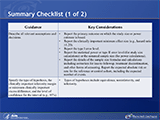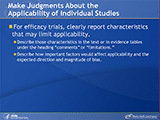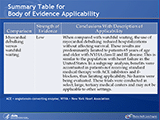- Home
- Slides
- Home
- Tools and Resources
- Research Summaries for Consumers, Clinicians, and Policymakers
- Search for Research Summaries, Reviews, and Reports
- Research Available for Comment
- Submit a Suggestion for Research
- Submit Scientific Information Packets
- Comparative Effectiveness Research Grant and ARRA Awards
- News and Announcements
- What Is Comparative Effectiveness Research
- Who Is Involved in the Effective Health Care Program
- What Is the Effective Health Care Program
Slides
Slides: 1–12 of 84
Outline of Material
Summary Checklist (1 of 2)
Keywords: summary checklist | study size | statistical methods
Summary Checklist (2 of 2)
Keywords: summary checklist | study size | statistical methods
Comparative Effectiveness of Standard Antibiotic Treatment for CDI
Clinical Questions Addressed by the CER (1 of 2)
Presentation: Analgesics for Osteoarthritis—An Update
Keywords: comparative effectiveness | systematic review | key question
Factors Affecting Outcomes: Demographic Subgroups
Presentation: Analgesics for Osteoarthritis—An Update
Keywords: CV risk | GI risk | NSAIDs | outcomes | strength of evidence | demographic subgroups
Make Judgments About the Applicability of Individual Studies
Presentation: Assessing Applicability
Keywords: efficacy trial | applicability | subgroup analyses | meta-regression | population
Step 3. Completed Applicability Summary Table
Presentation: Assessing Applicability
Keywords: population | applicability | subgroup analysis | outcome | setting
Summary Table for Body of Evidence Applicability
Presentation: Assessing Applicability
Keywords: applicability | body of evidence | strength of evidence | subgroup analysis
Clinical Questions Addressed by the CER (2 of 3)
Key Question 1: Clinical Bottom Line — Behavioral Interventions
Keywords: outcomes | strength of evidence | treatment | therapy | interventions | behavioral | benefits
Your slide tray is being processed.


 E-mail Updates
E-mail Updates










